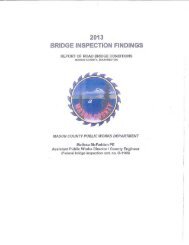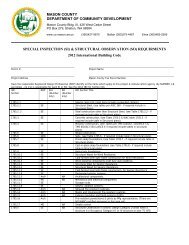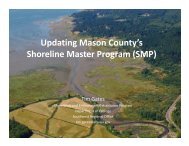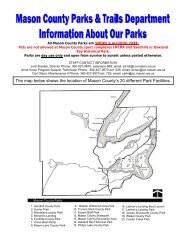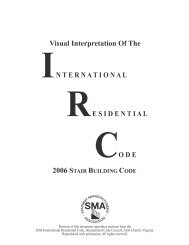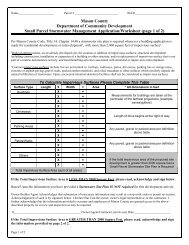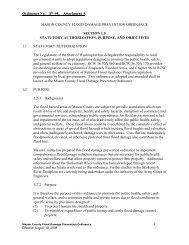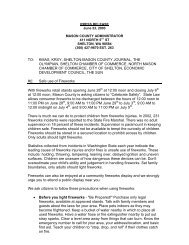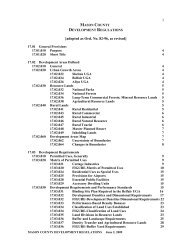Watershed Management Plan - Mason County
Watershed Management Plan - Mason County
Watershed Management Plan - Mason County
You also want an ePaper? Increase the reach of your titles
YUMPU automatically turns print PDFs into web optimized ePapers that Google loves.
Appendix<br />
B Key Issues and Options – Water Quantity<br />
The <strong>Plan</strong>ning Unit could recommend or partner with local wastewater<br />
treatment plants to explore opportunities to develop water reclamation<br />
capability in WRIA 16. The reclaimed water may be particularly useful for<br />
aquifer recharge if treated to sufficient levels.<br />
Option 13.<br />
Assess the benefits and impacts of drilling new<br />
wells into deeper aquifers<br />
Where groundwater quantity is limited or threatened by saltwater intrusion<br />
– or where groundwater withdrawals affect instream flows – planners could<br />
assess the benefits and drawbacks of drilling wells into deeper aquifers, if<br />
they exist. Deeper aquifers are not guaranteed to be free of the challenges<br />
faced by shallower aquifers, however. Still, withdrawing water from a<br />
deeper aquifer could relieve demand on the shallower aquifer and allow for<br />
recovery and restoration. Or, in some cases water from deeper aquifers<br />
could be used directly to recharge the shallow aquifer. Based on the results<br />
of such a study, the <strong>Plan</strong>ning Unit could promote the practice of drilling<br />
new wells into deeper aquifers.<br />
Option 14.<br />
Evaluate the need for the <strong>Mason</strong> <strong>County</strong> Water<br />
Conservancy Board<br />
Washington water law is complex, and the number of applications for new<br />
water rights and water rights adjustments far outpaces the Washington<br />
Department of Ecology’s ability to process them. Water Conservancy<br />
Boards may accept and process applications to change or transfer a water<br />
right under RCW 90.80. Because Conservancy Boards can process only<br />
water-right change applications, they do not need to wait for new waterright<br />
applications to be processed before they can address change<br />
applications (Washington Department of Ecology, 1999). As a result, they<br />
can process change applications much more quickly than Ecology can.<br />
However, Ecology reviews all of the Conservancy Board’s decisions, so<br />
while this process is helpful, it is not a cure.<br />
<strong>Mason</strong> <strong>County</strong>’s Water Conservancy Board was founded in 2002. The<br />
<strong>Plan</strong>ning Unit could recommend that <strong>Mason</strong> <strong>County</strong> conduct an<br />
independent evaluation of the Board’s activities and the need for the Board.<br />
Option 15.<br />
Participate in water right trust or banking<br />
programs<br />
Water right holders interested in conservation can voluntarily dedicate their<br />
rights to maintain stream flows. Organizations such as the Washington<br />
Water Trust and the Department of Ecology facilitate these efforts by<br />
acquiring water rights and dedicating them to preserving stream flow --<br />
essentially by agreeing not to use them. Rights are then held by the Trust<br />
Water Rights Program through the Department of Ecology (Washington<br />
Water Trust, 2005).<br />
page 102 Final <strong>Plan</strong> for <strong>County</strong> Adoption – May 11, 2006



